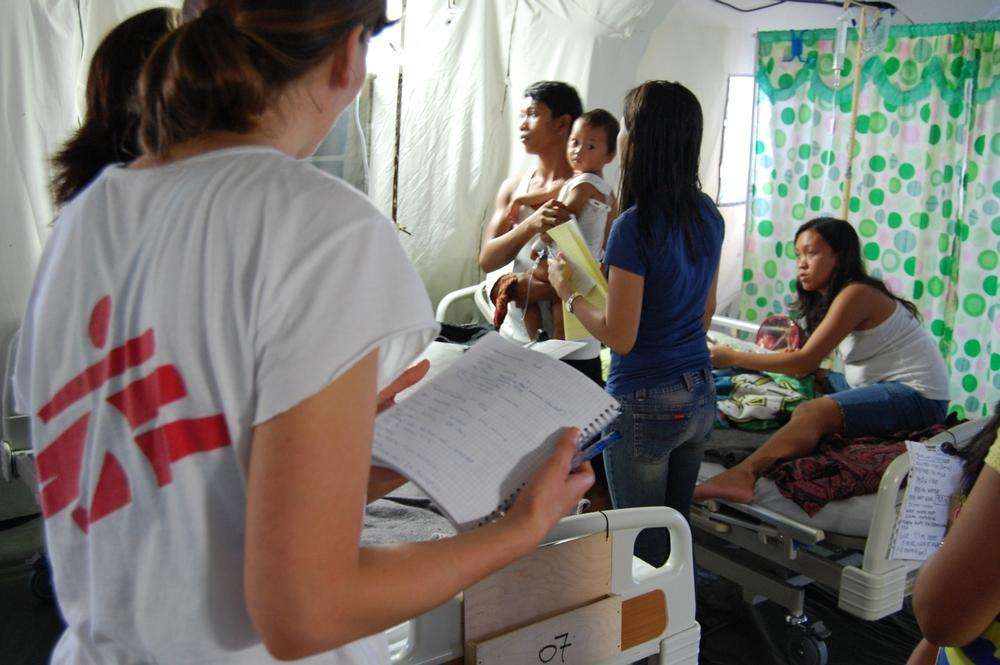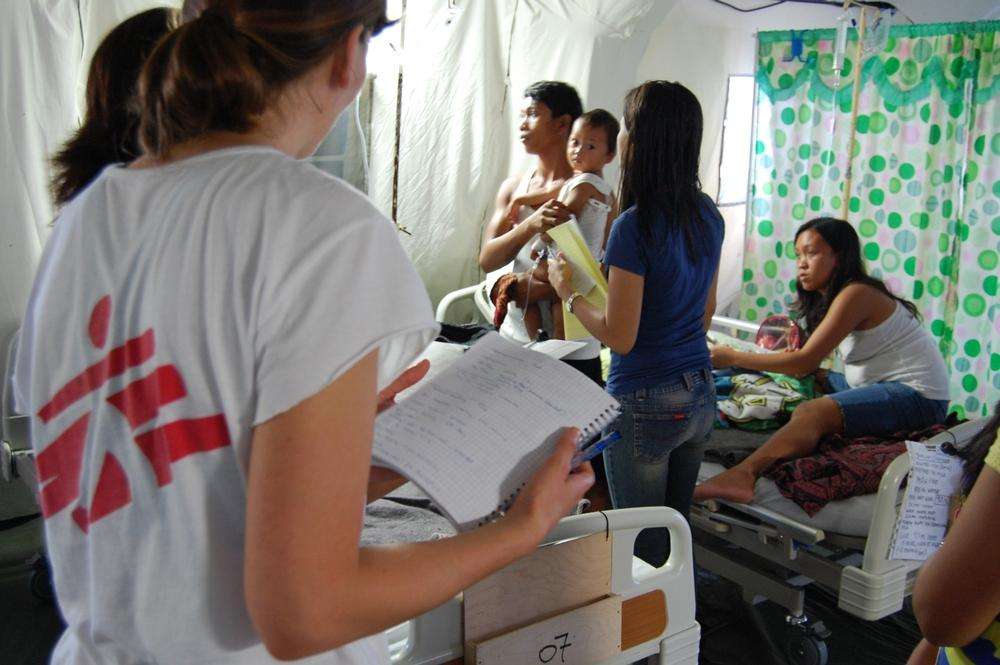Doctors Without Borders/Médecins Sans Frontières (MSF) doctor Natalie Roberts spent two months working in the Philippines, running MSF’s inflatable hospital in Tacloban. Here, she describes her experience.
I arrived in Tacloban a week after the typhoon. As soon as the town came into view from the air, the level of devastation became apparent. The runway was surrounded by debris—cars, bits of tin roofing, broken wood, as well as aid packages and military planes. Airport departures was just a hole in the wall, partially covered by mangled barbed wire.
Driving away from the airport, it looked post-apocalyptic. Few buildings were identifiable as houses, most were reduced to debris. It was really sad to see people picking through the ruins. Even a week after the typhoon, it seemed like people didn’t know what to do with themselves—they felt totally overwhelmed.
Driving away from the airport, it looked post-apocalyptic. Few buildings were identifiable as houses, most were reduced to debris. It was really sad to see people picking through the ruins.
We put our bags down in the disused hotel where we were staying and headed to the site chosen for the inflatable hospital: Bethany Hospital’s car park. We had to pick our way along the streets. About one meter had been cleared in the middle of the road. The smell was atrocious. What made it horrific was that you knew it was the smell of dead bodies.
The hospital itself was badly damaged. The rooms were covered in mud and the roof had blown off. We managed to salvage a couple of rooms to run an operating theater, a sterilization unit, X-ray services, and a maternity and neonatal unit. It’s unusual for MSF to run a baby unit in an emergency project, but we expected complicated deliveries and knew patients might not have anywhere else to go. The emergency room and the outpatient and inpatient departments would be housed in the tents.
We worked incredibly hard to get the site cleared. We already had a logistics team of 20, but everyone else got involved—even the surgeons and the medical team.
The hospital kit finally arrived on the evening of November 20. It was pouring rain but we worked through the night to put up three tents. After a couple of hours sleep we returned at 5:00 the next morning to put the rest up. On Thursday the medical team took over, staying all night to put up shelves, assemble beds, and unpack boxes of drugs and dressings. I think I slept for three hours out of 60. The outpatient department opened on Friday, and the rest of the hospital opened on Saturday.
We worked incredibly hard to get the site cleared. We already had a logistics team of 20, but everyone else got involved—even the surgeons and the medical team.
It didn’t take long for patients to start coming. We saw the conditions you would expect after a typhoon—people who had sustained wounds from floating debris, and those with upper respiratory tract infections and worsening of their chronic diseases. There are high rates of hypertension and diabetes in the Philippines anyway, and many people had lost their medication in the typhoon and could not replace it.
Some people had wounds in an advanced stage. The conditions were perfect for infections—it’s hot and wet in the Philippines, and people were wading through dirty water and couldn’t access medical care. We had to perform some amputations. We also saw many cases of pre-eclampsia—high blood pressure in pregnancy—which can be very dangerous. Under usual circumstances, rates of pre-eclampsia are high in the Philippines, but the stress of the typhoon seemed to have made them even higher.
We dealt with some shocking clinical cases of tetanus. One boy of 17 came in with a deep wound on his shin from the typhoon and the classic signs of tetanus: a locked jaw, muscle spasms, and extreme sensitivity to light and noise. His wound was badly infected, but we couldn’t clean it in surgery because we couldn’t give him an anesthetic—his jaw was so locked and his breathing could have been compromised. After a week of antibiotics we started taking him into surgery every couple of days to clean his wound. The whole team was following his case, but at the same time we knew that tetanus has a high mortality rate. When he finally walked out of the hospital it was an incredible moment for us all.
I’ve worked in the Philippines before, and I know that people rarely open up about anything sad or difficult. But after a couple of weeks our Filipino health workers started talking about the typhoon and were visibly upset and crying—something I’d never seen before.
A nurse told me that as the typhoon hit and the water began rising she put all of the neonatal unit babies into a single cot to try to save them. Other staff stayed to look after patients before walking long distances to get home, wading through water as bodies floated past. All the way home they didn’t know what had happened to their families—they were just hoping that they would find them alive.
We’re out of the emergency stage now but some parts of Tacloban remain devastated. There is a piece of land behind the hospital that looks like a steamroller has driven over it—it used to be full of houses. I’m always really struck by the plots that have no repair work underway; it makes you wonder what happened to the owners.
We’re still seeing strong demand for our services, and that’s why we’re staying for the foreseeable future. So far we’ve treated 6,000 people as outpatients, treated more than 1,000 emergency cases, performed more than 250 surgical procedures, and delivered more than 100 babies. I don’t think that level of demand will change any time soon.
All over Tacloban are posters and T-shirts that read tindog Tacloban—it means “rise up” in the local dialect—and people take it seriously.
At midnight on New Year’s Day we went up to the roof of our hotel. Only weeks earlier the place had been devastated, but now all over town fireworks were going off. After everything that has happened it was quite emotional to see. It really demonstrates the strength and resilience of the Filipino people. All over Tacloban are posters and T-shirts that read tindog Tacloban—it means “rise up” in the local dialect—and people take it seriously.
MSF is providing medical and humanitarian assistance on three islands that were battered by the typhoon. MSF supports hospitals in Tacloban and Burauen (on Leyte Island), Balasan (on Panay Island), and Guiuan (on Samar Island) with the aim of helping to restore normal medical services as quickly as possible. The support includes repairing damaged buildings; providing medical supplies, drugs and staff; and setting up an ambulance service.





